
Evidence is provided to link these four market environments to specific investment methods that tend to outperform or underperform during each environmental time period. An actionable approach for investors to capitalize on this information is posited with the creation of “Multi-Method Investing”, a new form of investment management methodology, and evidence is provided to support the use of this approach over the widely accepted single-method approaches currently in use in the investment management industry today.
Introduction
Four Alternative Categories Of Investment Method
Markets Redefined As Bear, Bull, Wolf, Eagle
Market Sequences And Unpredictability
The Logical Link Between Market Environment And Investment Method
The Statistical Link Between Market Environment And Investment Method
Comparative performance characteristics of investment methods across all 4 market environments
Summary of Key Findings and Concepts
Share This Article
Financial market history has traditionally been defined as an alternating progression of “Bull” and “Bear” markets, with Bull markets loosely representing rising asset prices, and Bear markets representing declining asset prices. This is a simple and convenient way to describe the investing experience, and is at least partially responsible (along with the bulk of the literature on Modern Portfolio Theory) for the widely held belief that the best way to diversify an investment portfolio is to use an allocation split between stocks and bonds (as stocks do well in a stock Bull market, and bonds may do comparatively better in a stock Bear market - due to their low or negative expected returns correlations). But labelling markets as either Bull or Bear is probably a gross oversimplification of financial market realities. The author does not presume to have found a perfect replacement to the traditional Bull/Bear approach that fully explains all financial market environments, but does posit that the simple addition of two new categories of market environment to the mix – “Wolf ” markets and “Eagle” markets - dramatically reshapes the perspective from which one views financial market history and may have profound implications for the way that an investment portfolio should be managed.
Our initial research began in 2007-2008 during the depths of the global financial crisis as an attempt to find or confirm the “best” way to manage investment portfolios, given that our firm’s then-current and widely accepted approach to asset management (“Strategic Asset Allocation” derived from “Modern Portfolio Theory”) was being called into question by clients, academics, the financial media, industry professionals, and just about every other potential critic. As a matter of due diligence, self-confidence, and in an effort to confirm that we were still applying the most practical and effective method of investing for our clientele, we embarked on an internal research project - to start from scratch and re-examine financial market history on our own terms, leaving our presuppositions derived from 50+ years of the aggregated academic research of others aside. What we found reshaped our entire understanding of financial markets and investing, and ultimately led to our development of a new methodology of investment management – “Multi-Method Investing®” (MMI).
The information in this article represents a portion of our own internal research conducted over the last decade, presented here in a format intended to be more concise and intelligible for the reader.
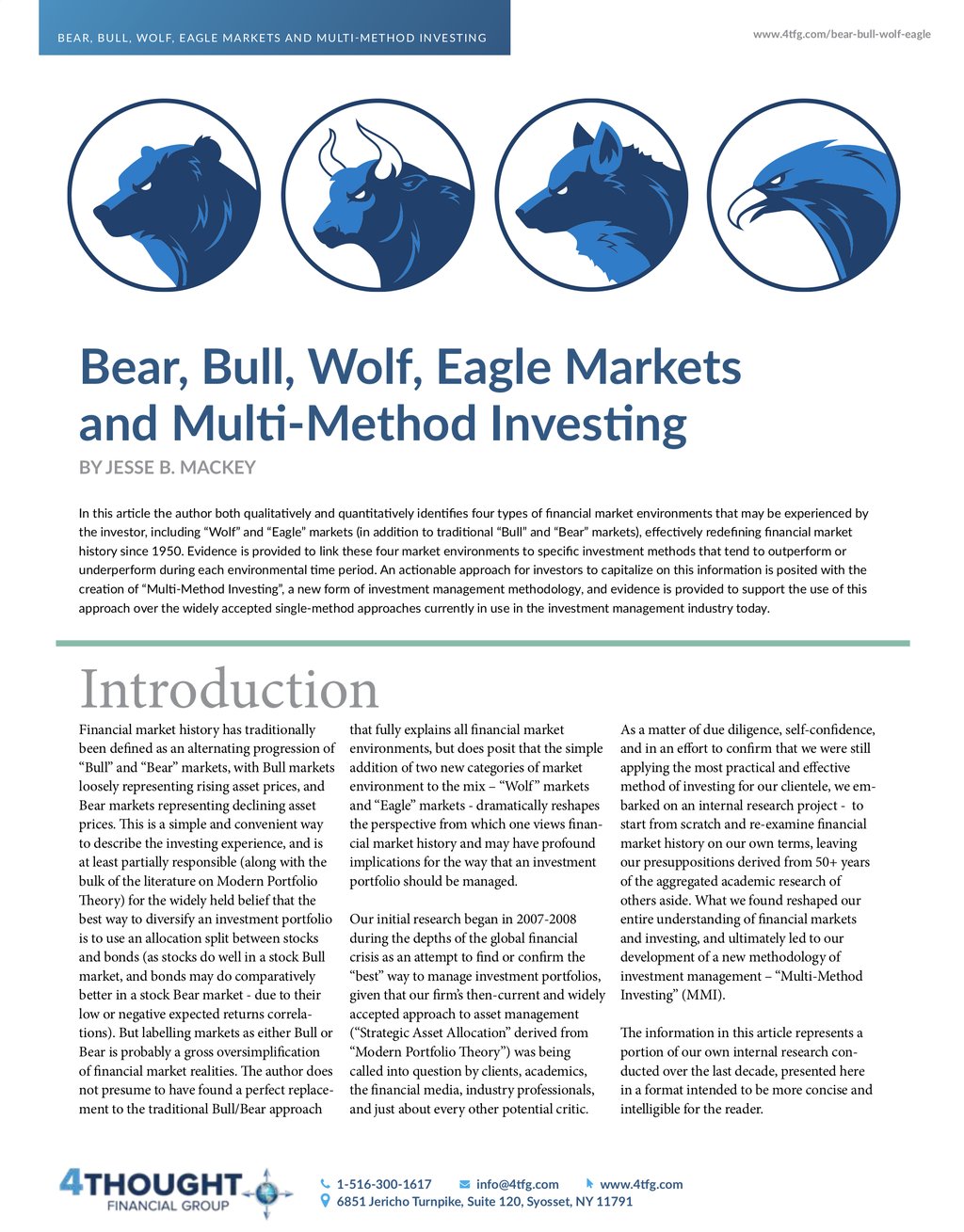
Understanding “Wolf” and “Eagle” markets, in addition to the traditional “Bull” and “Bear”, and how select investment methods tend to perform in each environment.
Four Alternative Categories Of Investment Method
Markets Redefined As Bear, Bull, Wolf, Eagle
Market Sequences And Unpredictability
The Logical Link Between Market Environment And Investment Method
The Statistical Link Between Market Environment And Investment Method
Comparative performance characteristics of investment methods across all 4 market environments
Summary of Key Findings and Concepts
Share This Article
We started by looking at mutual fund performance data during historical time periods of market turmoil. Mutual fund data was chosen because this is the one appropriate investment vehicle for which extensive and reliable historical records exist. By sorting for the best performance across all mutual funds available (not just within individual categories/styles) during predetermined particularly difficult market periods and excluding strategies whose mandates were too narrow or asset-class-specific, we began to identify individual mutual fund managers/strategies that appeared to be particularly well-adapted to such market environments. Studying the management approach of these time-period-specific top performing managers revealed that they tended to share a similar approach to investing. We then extended our search to historical time periods with benign or favorable environments for stocks. Repeating the process, we found a totally different set of managers and mandates that appeared particularly well-adapted to these environments. We then began to categorize the investing approaches used by the top performing managers (and all other managers) into different philosophies or “methods” (which is the term we’ll use here). We ultimately found that there are four basic categories of investment method that can be utilized by an investor to attempt to achieve his or her objectives:
1. Liability-Driven Investing (LDI): LDI is often used by large institutions such as banks, insurance companies, and pension funds. It is based on the concept of directly matching investor assets with the entity’s known, quantifiable risks and liabilities in an attempt to transfer these (and possibly market-related risks) to another party. It often involves the heavy use of fixed income (bond) and derivative instruments.
2. Strategic Asset Allocation (SAA): Strategic Asset Allocation is the most widely utilized and accepted method of investment, based on the original work of Harry Markowitz and his researcher contemporaries in developing Modern Portfolio Theory. In common practice it involves setting a predetermined percentage split between stocks, bonds, and other asset types (an asset allocation); diversifying by asset type and number of securities as much as possible within these categories; and rebalancing back to the original splits as market values shift (making target allocation changes only as necessary based on changes in the investor’s objectives, risk tolerance, and life cycle).
3. Opportunistic Investing (OPP): Opportunistic Investing is a very broad category that encompasses a vast number of sub-categories, all of them sharing the goals of beating the market (either on the upside, the downside, or both) or providing low correlation returns with the more traditional stock/bond portions of an investor portfolio. The strategies used in many hedge funds fit in this category, as do tactical asset allocation approaches and absolute return strategies. Based on our definition, opportunistic strategies are mainly focused on taking advantage of asset class market timing opportunities, and not necessarily on opportunities related to individual companies or stocks.
4. Selective/Concentrated Investing (SEL): Selective or Concentrated Investing is the oldest form of investing, and involves taking positions in one or more individual companies/securities in an attempt to take advantage of some inefficiency related to the price of that security, to capitalize on an associated idiosyncratic risk of the stock, or in expectation of future growth in the company. Many private equity funds apply this method, as do many of the more selective “Value” and “Growth” styles of stock investing. The basic premise is that by knowing as much as possible about the very few positions one is invested in and acting on information related to them, it may become possible to beat the market or a more diversified portfolio over the long term.
During our mutual fund analysis process, we began to notice and accumulate more detailed anecdotal evidence on which investment method categories were most successful (relative to the other categories) in each market environment. We found the following:
Four Alternative Categories Of Investment Method
Markets Redefined As Bear, Bull, Wolf, Eagle
Market Sequences And Unpredictability
The Logical Link Between Market Environment And Investment Method
The Statistical Link Between Market Environment And Investment Method
Comparative performance characteristics of investment methods across all 4 market environments
Summary of Key Findings and Concepts
Share This Article
 Bear Markets (Declining stock prices): Quantitatively defined as a period of cumulative price decrease of 20% or greater from the most recent record peak price.
Bear Markets (Declining stock prices): Quantitatively defined as a period of cumulative price decrease of 20% or greater from the most recent record peak price.
 Bull Markets (Rising stock prices): Quantitatively defined as any period that does not meet the criteria for a Bear Market (Anything other than a period of price decrease of 20% or greater from the most recent record peak price. Bull and Bear markets are mutually exclusive by definition).
Bull Markets (Rising stock prices): Quantitatively defined as any period that does not meet the criteria for a Bear Market (Anything other than a period of price decrease of 20% or greater from the most recent record peak price. Bull and Bear markets are mutually exclusive by definition).
 Wolf Markets (Volatile/sideways stock prices): Quantitatively defined as any period of 10% or greater downward price correction, starting with the day of the initial peak price and ending at the day before the initial peak price is reached again; We also include any period with two consecutive 10%+ downward corrections (excluding periods defined as Bear markets) with no increase in price from the trough of the first correction to the trough of the second correction (ending after the 2nd trough on the day before the initial price of the 1st correction’s starting peak is reached).
Wolf Markets (Volatile/sideways stock prices): Quantitatively defined as any period of 10% or greater downward price correction, starting with the day of the initial peak price and ending at the day before the initial peak price is reached again; We also include any period with two consecutive 10%+ downward corrections (excluding periods defined as Bear markets) with no increase in price from the trough of the first correction to the trough of the second correction (ending after the 2nd trough on the day before the initial price of the 1st correction’s starting peak is reached).
 Eagle Markets (Rapidly rising stock prices with low volatility): Quantitatively defined as any period exhibiting trailing 1-year returns of +30% or greater without an intervening 10% or greater downward price correction.
Eagle Markets (Rapidly rising stock prices with low volatility): Quantitatively defined as any period exhibiting trailing 1-year returns of +30% or greater without an intervening 10% or greater downward price correction.
It is important to note that based on these quantitative definitions of the Bear, Bull, Wolf, and Eagle environments, markets can overlap with each other. With the exception of Bear markets, the other three market types can occur simultaneously. In effect, based on this “overlapping” set of definitions (which have been used to preserve the traditional mutually exclusive definitions of Bull and Bear markets), our newly identified Wolf and Eagle markets can be viewed as subsets or components of the traditional Bull market.
We recently reapplied these quantitative definitions to the available 68 years of price history of the S&P 500 Index from January 1950 to December 2017 (using the S&P 500 price return index). The results are presented here in the accompanying EXHIBIT 1.
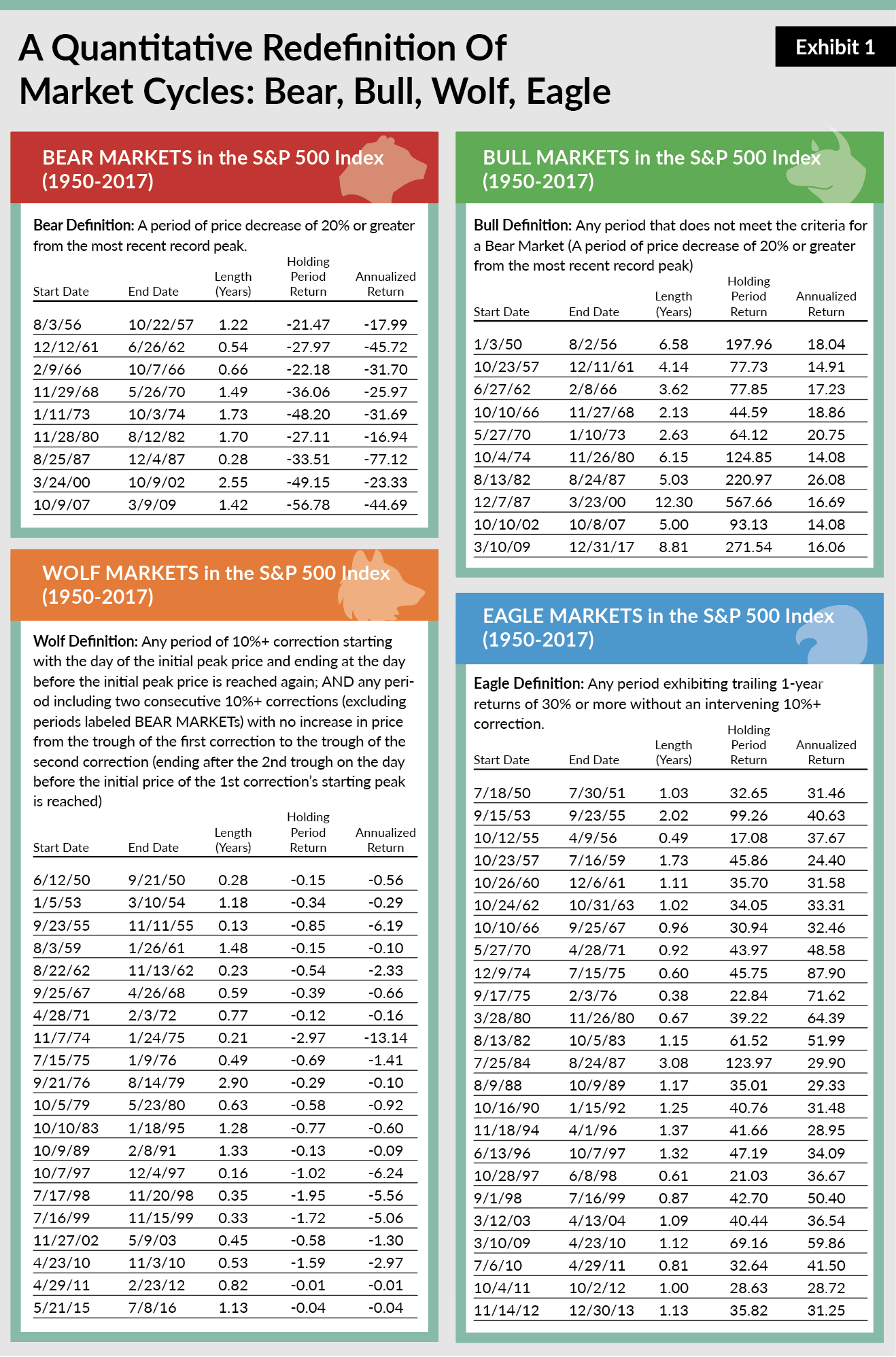
There were 9 Bear Markets in the S&P 500 from 1950 to 2017 (in 68 years). These accounted for 11.57 years in total (17.01% of the history of the S&P 500 Index). The average length of a Bear Market was 1.29 years (15.48 months). The shortest was 0.28 years (3.36 months), and the longest was 2.55 years (30.60 months). The average cumulative drawdown (loss) per Bear Market was -35.83%, with the largest drawdown at -56.78%, and the smallest drawdown at -21.47%. The average rate of loss during a Bear Market was -35.02%/year, with the steepest rate at -77.12%/year, and the shallowest at -16.94%/year.
There were 10 Bull Markets in the S&P 500 from 1950 to 2017 (in 68 years). These accounted for 56.40 years in total (82.99% of the history of the S&P 500 Index). The average length of a Bull Market was 5.64 years (67.68 months). The shortest was 2.13 years (25.56 months), and the longest was 12.30 years (147.60 months). The average cumulative gain per Bull Market was +174.04%, with the largest gain at +567.66%, and the smallest gain at +44.59%. The average rate of gain during a Bull Market was +17.68%/year, with the steepest rate at +26.08%/year, and the shallowest at +14.08%/year.
There were 20 Wolf Markets in the S&P 500 from 1950 to 2017 (in 68 years). These accounted for 15.27 years in total (22.46% of the history of the S&P 500 Index). The average length of a Wolf Market was 0.76 years (9.12 months). The shortest was 0.13 years (1.56 months), and the longest was 2.90 years (34.80 months). The average cumulative return per Wolf Market was -0.74%, with the highest return at -0.01%, and the lowest return at -2.97%. The average rate of return during a Wolf Market was -2.39%/year, with the steepest rate at -13.14%/year, and the shallowest at -0.01%/year.
There were 24 Eagle Markets in the S&P 500 from 1950 to 2017 (in 68 years). These accounted for 26.89 years in total (39.54% of the history of the S&P 500 Index). The average length of an Eagle Market was 1.12 years (13.44 months). The shortest was 0.38 years (4.56 months), and the longest was 3.08 years (36.96 months). The average cumulative gain per Eagle Market was +44.49%, with the largest gain at +123.97%, and the smallest gain at +17.08%. The average rate of gain during an Eagle Market was +41.45%/year, with the steepest rate at +87.90%/year, and the shallowest at +24.40%/year.
For purposes of comparison of the EXHIBIT 1 results, first consider that the traditional 2-environment approach to market history analysis results in Bear markets accounting for 17.01% of the history of the S&P 500 Index, and Bull markets accounting for the entirety of the remainder (82.99% of market history). But if we now separate out Wolf and Eagle markets as subcomponents of the Bull market using our 4-environment approach, we find that Bear markets account for 17.01% (the same as before), Bull markets account for 82.99% (the same as before), Wolf markets account for 22.46% (a new subcomponent), and Eagle markets account for 39.54% (a new subcomponent). The total percentage of market history when adding these four proportions together exceeds 100% because we are double-counting the portion of the broader Bull markets that overlap with Eagle and Wolf markets. Again, this is based on the use of overlapping quantitative definitions that preserve the conventional Bull and Bear definitions, and view Wolf and Eagle markets as subcomponents of the Bull market. So, it is important to note that if an alternative “mutually exclusive” definition of the 4 market environments is used (in which we assume only one of the 4 environments can occur at any one time) instead of the “overlapping” definitions used here, then time periods identified as “Bull Only” (in which none of the other 3 environments is indicated) account for only 5,970 days (or 24%) of the calendar days from 1950-2017. This is in stark contrast to the traditional definition of the Bull market used in our analysis, in which the Bull market accounts for 20,524 days (or 82.69%) of the calendar days from 1950-2017. Under a mutually exclusive definition of the 4 market environments, Bear Markets account for 17% of market history, Bull Markets 24%, Wolf Markets 22%, and Eagle Markets 34% (3% is inconclusive). This is an astonishing result. This means that Wolf and Eagle markets account for a very large proportion of market history, regardless of whether the “mutually exclusive” or “overlapping” definitions are used (even more so with the “mutually exclusive” approach). It follows that if investment assets, strategies, or methods can be found that can perform well in these two newly identified market environments, then perhaps they should be utilized as substantial components within an investor portfolio (possibly in very large proportions, depending on the capital allocation approach).
Four Alternative Categories Of Investment Method
Markets Redefined As Bear, Bull, Wolf, Eagle
Market Sequences And Unpredictability
The Logical Link Between Market Environment And Investment Method
The Statistical Link Between Market Environment And Investment Method
Comparative performance characteristics of investment methods across all 4 market environments
Summary of Key Findings and Concepts
Share This Article
With the knowledge that the 4 market types can overlap with each other, we then conducted measurement of their interactions with one another by looking at the sequence of these market environments through time. The results (for the S&P 500 price return index for the period from January 1950 to December 2017) are presented here in the accompanying EXHIBIT 2.
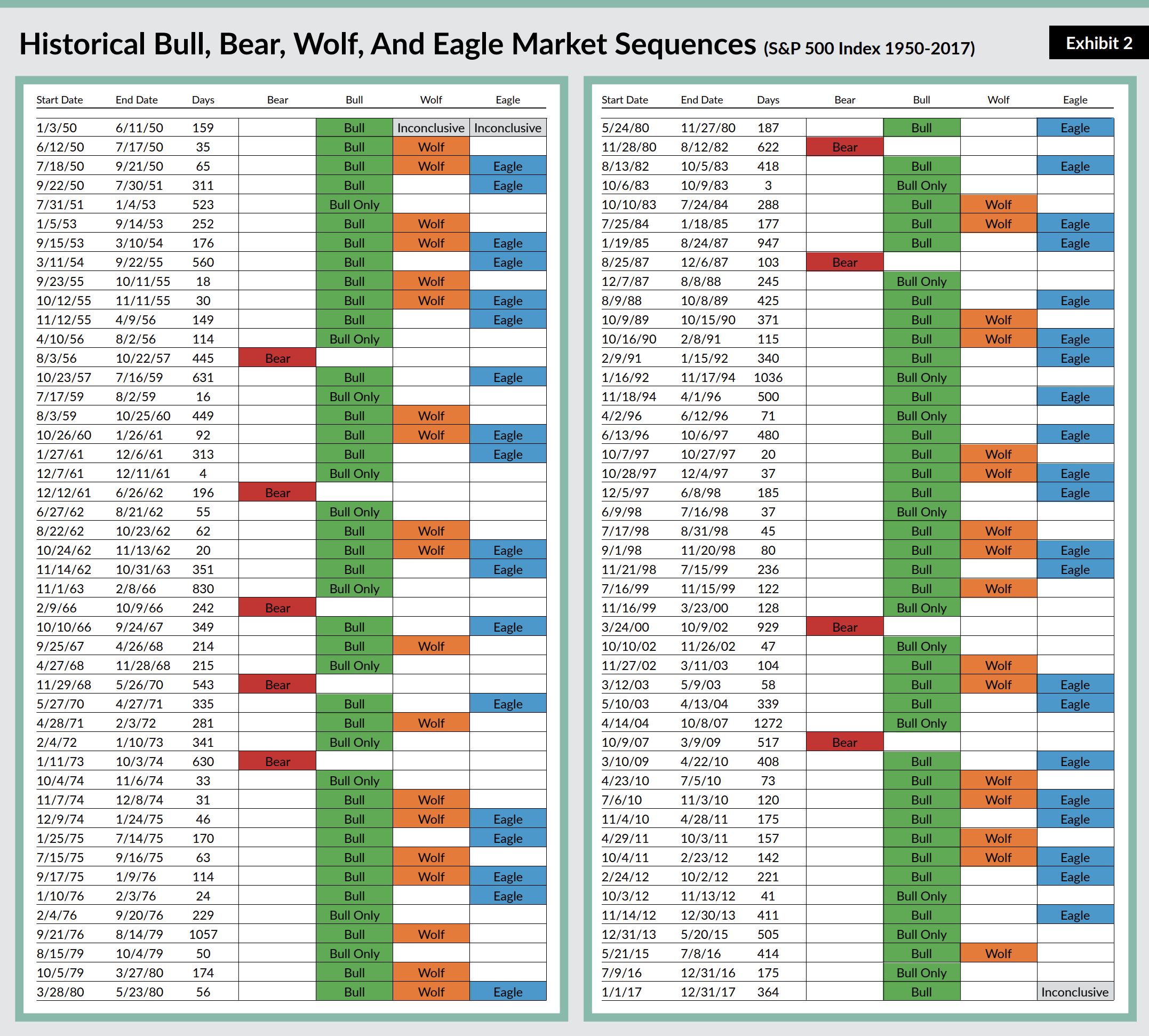
The sequence of the traditional 2-market definition of market cycles (Bear and Bull markets) is always the same based on the two environments’ mutual exclusivity (they always alternate Bull, Bear, Bull, Bear, Bull, Bear, etc.). Despite this seeming predictability, the ability of most investors to accurately time the market cycles (for example, by switching between stocks and bonds) has historically been terrible. This is because while the alternating sequence is always the same, the length of each Bull and Bear market is always different. This makes effective market timing extremely difficult. However, things become even more complex if one uses our 4-market redefinition, as shown in the table. The sequence of Bear, Bull, Wolf, and Eagle markets has not always followed the same pattern historically. Although a common historically occurring transition sequence is BEAR, BULL, WOLF, EAGLE, the markets can be sequenced totally differently, and they can overlap in a variety of combinations. Also, in an attempt at market timing we still have the problem of different lengths of each occurrence of the market types from one cycle to the next (just as with the easily sequenced traditional Bull/Bear market definitions). This new perspective reveals substantially greater complexity to market history than a traditional Bull/Bear perspective, and adds another layer of unpredictability to timing market cycles (and investment methods). Furthermore, it is important to note that in the EXHIBIT 2 table on market sequences, the final time period listed (from 1/1/17 to 12/31/17) has an “Inconclusive” indicator for Eagle markets. This is important because it shows that one never knows exactly which type of market environment (or combination of them) one is presently experiencing at any given time. Instead, one must wait until after the quantitative definition has been met (in arrears) before it becomes clear what type of environment they have just been in (one that may have already passed entirely). One cannot say what type of market environment one is in until after the fact, so it is unclear whether knowledge of the most recent market environment type has any predictive power for determining continuation or future experience. Therefore, it does not appear that one should expect to be able to accurately and consistently time a shift from one market environment to another over time.
Four Alternative Categories Of Investment Method
Markets Redefined As Bear, Bull, Wolf, Eagle
Market Sequences And Unpredictability
The Logical Link Between Market Environment And Investment Method
The Statistical Link Between Market Environment And Investment Method
Comparative performance characteristics of investment methods across all 4 market environments
Summary of Key Findings and Concepts
Share This Article
Our research led us to next analyze data linking the performance of the four broad investment method categories (Liability-Driven Investing, Strategic Asset Allocation, Opportunistic Investing, and Selective/Concentrated Investing) to each of the four market environments (Bear, Bull, Wolf, and Eagle). As mentioned earlier, this was initially prompted by noticing anecdotal evidence within historical mutual fund data (amongst top managers). We noticed that during specific market environments, there was often a contingent of professionally managed mutual funds using a similar approach or method of investing (not specific to an asset class or other narrow mandate) that significantly (sometimes dramatically) outperformed all of the other categories of funds. Different market environments seemed to coincide with the outperformance of different sets of mutual funds and categories of investment management methods. Importantly, we also found an intuitive logic for each pairing of investment method to market environment type:
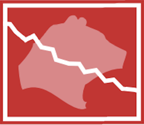 Liability-Driven Investing and Bear Markets
Liability-Driven Investing and Bear MarketsLiability-Driven Investing may have the potential to outperform the other three methods during a Bear market. If one has transferred his/her market risk to another party through the purchase of fixed income securities, derivatives, or insurance contracts, then a significant decline in stock prices is not likely to be as detrimental to the portfolio as it would be under any of the other three methods. This is because the other three methods by their very nature are likely to have some exposure (or at least potential exposure) to stocks at all times. Strategic Asset Allocation will always have a permanent allocation to stocks. Selective/Concentrated Investing also will always have a permanent (if not revolving) allocation to stocks (assuming it is an equity portfolio). Opportunistic Investing always has the potential for exposure to stocks at the wrong time, even if the portfolio has the flexibility to temporarily allocate to bonds, cash, or other asset classes. In Liability-Driven Investing, the investor has the potential to transfer his/her risks to another party in advance in order to hedge/insure against a Bear market potentiality.
 Strategic Asset Allocation and Bull Markets
Strategic Asset Allocation and Bull MarketsStrategic Asset Allocation may have the potential to outperform the other three methods during a Bull market. If stock prices are rising on average, then a thoroughly diversified portfolio of stocks will rise on average as well. It will do this with greater reliability than any alternative approach that would require either a market timing or security bet (some of which will be winners, and some of which will be losers), or an investment in bonds or derivatives contracts (which are historically likely to either lag stocks, hold value, or decline in value in a rising market). Liability-Driven Investing requires the transfer of risk to another party, which will result in an opportunity cost (if fixed income is used) while being out of the stock market or the payment of an insurance premium (through either a derivative contract or traditional insurance contract). Opportunistic Investing typically involves a directional bet on asset classes, the broad stock market, or specific securities, which involves the potentiality (and likelihood) of being out of the stock market for at least a portion of the time during which it is rising – leading to inferior performance relative to Strategic Asset Allocation. Selective/Concentrated Investing also involves the necessity of being more concentrated in one or more securities – and thus a departure from the stock market indexes. But if the Bull market is broad based and most asset prices are rising, then selecting specific securities may only pose an unnecessary risk (of selecting the few securities that aren’t rising as fast) and is also likely to generate transactional friction as the portfolio is shifted – leading to underperformance. Strategic Asset Allocation, however, will have a similar broad exposure to the stock index, and will thus receive the most reliable benefit from the rising market on average.
 Opportunistic Investing and Wolf Markets
Opportunistic Investing and Wolf MarketsOpportunistic Investing may have the potential to outperform the other three methods during a Wolf market. In an environment of heightened volatility, strategies that are specifically designed to capture/attack the risk premium associated with this volatility at least have the potential (if not a higher probability) to outperform strategies that resign themselves to simply moving with the market and make no attempt to capitalize on it at all. Strategic Asset Allocation is likely to produce a return of roughly zero during such an environment since it will by definition remain invested in an index-like portfolio without tactical manipulation during a time in which the broad market index is also (by definition) producing zero returns (or close to it). Selective/Concentrated Investing (in stocks) is also likely to underperform for the same reasons as Strategic Asset Allocation, except that results may further depend on the sub-method of investing used (ie. Fundamental/Value stock investing may perform relatively well, while Momentum/Growth may perform very poorly). While Liability-Driven Investing may also be expected to perform reasonably well relative to Strategic and Selective (because fixed income will continue climbing at its slow and steady pace, and derivatives/insurance contracts could be used to directly hedge against volatility such as with VIX futures), LDI would in theory only hedge out the volatility risk, providing a zero excess return over the hedging objective. Opportunistic Investing on the other hand, has the theoretical potential to provide positive absolute/excess returns in such an environment – but only if the correct tactical moves are made (which is much easier to theorize on than to practice effectively).
 Selective/Concentrated Investing and Eagle Markets
Selective/Concentrated Investing and Eagle MarketsSelective/Concentrated Investing may have the potential to outperform the other three methods during an Eagle market. In an environment of soaring asset (stock) prices and low volatility, one of the only ways to beat the broader market indexes is to be different than the broader index but still remain in stocks, which by definition requires being more concentrated than the index (either in those securities that are dragging up the indexes’ average return or in securities that are not in the index at all and are outperforming it). Opportunistic Investing strategies designed to capitalize on volatility will do poorly here both because there is no volatility, and because they have the potential to hold assets other than stocks while stock prices are rising rapidly (creating a drag on relative returns). Strategic Asset Allocation strategies designed for diversity may keep pace with the market, but they are unlikely to significantly outpace it (because by definition they will be tracking it – at least roughly). Liability Driven Investing strategies designed for risk transfer are likely to be missing out on the stock market rally because they had already transferred their stock market risk to another party. They are likely to be earning a lower return on fixed income or even losing money by paying an insurance premium for a derivative contract or traditional insurance contract. Selective/Concentrated Investing on the other hand, has the theoretical potential to provide positive excess returns above the broader stock markets in such an environment – but only if the correct securities are selected (which is much easier to theorize on than to practice effectively).

Understanding “Wolf” and “Eagle” markets, in addition to the traditional “Bull” and “Bear”, and how select investment methods tend to perform in each environment.
Four Alternative Categories Of Investment Method
Markets Redefined As Bear, Bull, Wolf, Eagle
Market Sequences And Unpredictability
The Logical Link Between Market Environment And Investment Method
The Statistical Link Between Market Environment And Investment Method
Comparative performance characteristics of investment methods across all 4 market environments
Summary of Key Findings and Concepts
Share This Article
Mutual fund based analysis: The initial realization of the potential link between market environment and investing method was derived from examining mutual fund data related to top managers only. But the problem with conducting a more comprehensive analysis of the relationship between market environment and investment method using all available mutual funds (not just the top managers) is that they are not categorized by the four investment methods (as we’ve defined them) by any of the major research databases, so we would have to manually individually analyze the management approaches of each of the 27,000+ open-end mutual funds available in the US marketplace in order to categorize them. This is a prohibitive approach, but is perhaps worth pursuing in the future. A more expedient but less comprehensive approach, which we’ve used here in EXHIBIT 3, is to select proxies for each of the 4 investment methods in the form of market indexes.
Index based analysis: There are significant shortcomings to using a set of indexes as proxies for investment methods, mainly because there are no indexes in existence that are specifically designed to track the 4 investment methods as we’ve defined them. Instead we’ve had to substitute in pre-existing indexes that come as close as possible to mimicking a portfolio manager or algorithm applying the respective investment method. This approach is especially problematic with Opportunistic Investing (as we’ve defined it) because the hedge fund index used for measurement here in EXHIBIT 3 tracks a wide array of strategies, many of which are not specifically designed to capitalize on volatility (which is probably necessary to excel in an environment of volatility). This leads to what is likely an imprecise or unrepresentative measurement of the method. An additional and important shortcoming is the lack of available historical track record on these indexes. The EXHIBIT 3 analysis only goes back to the earliest common start date of the 4 indexes utilized, which is December 31st, 2002. Therefore, this small sample analysis provides only a glimpse at how the 4 investment methods may have corresponded to the 4 market environments in a broader historical context.
* Time periods of less than 1 year have not been annualized.
** The returns shown for each of the methods during the Bull Market from 10/10/02 to 10/8/2007 are calculated with the start date of 12/31/02, which is the earliest common start date available for all 4 of the indexes used as proxies for the methods.
*** The returns shown for each of the methods during the Wolf Market from 11/27/2002 to 5/9/2003 are calculated with the start date of 12/31/02, which is the earliest common start date available for all 4 of the indexes used as proxies for the methods
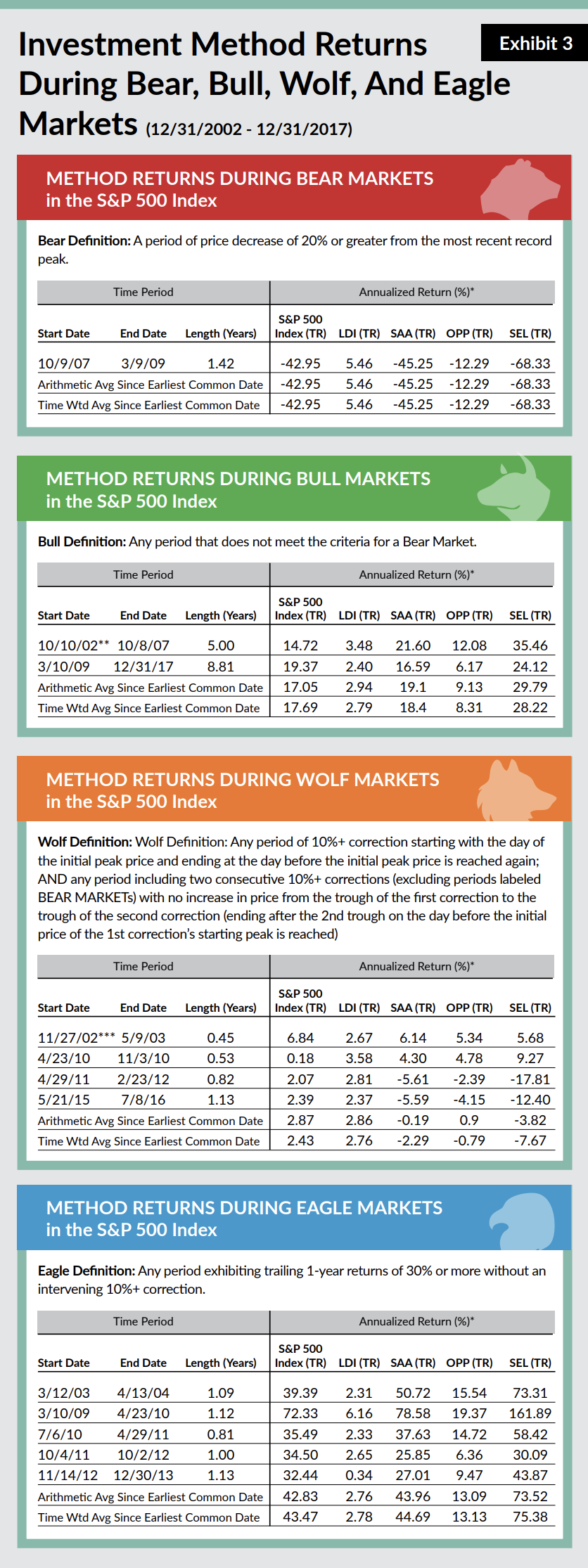
1. Liability-Driven Investing (LDI) - Bloomberg Barclays US Aggregate 1-5 Year Bond TR USD
• This is a short term US bond index
2. Opportunistic Investing (OPP) - Credit Suisse Hedge Fund USD
• This is an index of multiple aggregated hedge fund strategies
3. Strategic Asset Allocation (SAA) - FTSE Global All Cap TR USD
• This is a market cap weighted index of global stocks
4. Selective/Concentrated Investing (SEL) - Red Rocks Listed Private Equity TR USD
• This is an index of global publicly listed private equity firm stocks
The “Arithmetic Avg Since Earliest Common Date” shown above is calculated by dividing the sum of each of the cumulative returns for each market instance by the number of market type instances identified. It is a measure of the average cumulative return per market type instance (regardless of how long the instance lasted).
The “Time Wtd Avg Since Earliest Common Date” shown above is calculated by weighting the sum of each of the cumulative returns for each market instance with its corresponding time duration. It is a measure of the average cumulative return during the aggregate time period of all instances (it gives greater weighting to market instances that lasted longer).
This occurred from 10/9/2007 to 3/9/2009 (the Great Recession / Global Financial Crisis). During this time period Liability-Driven Investing was by far the best performing investment method, with a both an arithmetic and time-weighted average return of +5.46%. The second best was Opportunistic Investing (with both an arithmetic and time-weighted average return of -12.29%), followed by Strategic Asset Allocation (with both an arithmetic and time-weighted average return of -45.25%), and finally Selective/Concentrated Investing (with both an arithmetic and time-weighted average return of -68.33%).
During these time periods Liability-Driven Investing was the best performing method (with an arithmetic average return of +2.86% and a time-weighted average return of +2.76%). The second best was Opportunistic Investing (with an arithmetic average return of +0.90% and a time-weighted average return of -0.79%), followed by Strategic Asset Allocation (with an arithmetic average return of -0.19% and a time-weighted average return of -2.29%), and finally Selective/Concentrated Investing (with an arithmetic average return of -3.82% and a time-weighted average return of -7.67%).
During these time periods Selective/Concentrated Investing was the best performing method (with an arithmetic average return of +29.79% and a time-weighted average return of +28.22%). The second best was Strategic Asset Allocation (with an arithmetic average return of +19.10% and a time-weighted average return of +18.40%), followed by Opportunistic Investing (with an arithmetic average return of +9.13% and a time-weighted average return of +8.31%), and finally Liability-Driven Investing (with an arithmetic average return of +2.94% and a time-weighted average return of +2.79%).
During these time periods Selective/Concentrated Investing was by far the best performing method (with an arithmetic average return of +73.52% and a time-weighted average return of +75.38%). The second best was Strategic Asset Allocation (with an arithmetic average return of +43.96% and a time-weighted average return of +44.69%), followed by Opportunistic Investing (with an arithmetic average return of +13.09% and a time-weighted average return of +13.13%), and finally Liability-Driven Investing (with an arithmetic average return of +2.76% and a time-weighted average return of +2.78%).
Four Alternative Categories Of Investment Method
Markets Redefined As Bear, Bull, Wolf, Eagle
Market Sequences And Unpredictability
The Logical Link Between Market Environment And Investment Method
The Statistical Link Between Market Environment And Investment Method
Comparative performance characteristics of investment methods across all 4 market environments
Summary of Key Findings and Concepts
Share This Article
Liability-Driven Investing was the best performer during both Bear Markets and Wolf Markets, and produced positive annualized returns during all 4 market environments on average (although these returns were in the low-to-mid single digits in all cases). It was the worst performer during Bull and Eagle markets (but still not negative).
Strategic Asset Allocation was not the best performer during any of the 4 market environments, but it was also never the worst performer. It was number 3 during both Bear and Wolf markets, and number 2 during both Bull and Eagle markets. It provided a relatively stable “middle of the pack” performance across all market environments, but outperformed the other “middle of the pack” performer (Opportunistic Investing) during both Bull and Eagle markets.
Opportunistic Investing was also never the best performer or the worst performer. It was number 2 during both Bear and Wolf markets, and number 3 during both Bull and Eagle markets. It (like Strategic Asset Allocation) provided a relatively stable “middle of the pack” performance across all market environments, but outperformed the other “middle of the pack” performer (Strategic Asset Allocation) during both Bear and Wolf markets.
Selective/Concentrated Investing was the best performer during both Bull and Eagle markets, and produced very high positive annualized returns during these 2 market environments on average (in some cases high double or even triple digits). It was the worst performer during both Bear and Wolf markets (often by a very large margin to the next-worst performer – losing nearly 70% during the single Bear market measured).
It is important to note that although in this particular analysis the exact expectations for the outperformances of Opportunistic Investing and Strategic Asset Allocation in their respective market environments were not confirmed through measurement, this does not invalidate the overarching statement that each of the 4 methods of investment has its respective place in the portfolio management pantheon, and that we can have a reasonable expectation of differentiated risk and return performance between them during the 4 different market environments (and combinations thereof) over time. It is conceptually clear that the methods have historical (and thus expected future) returns correlations of less than +1.00, and could therefore provide diversification benefits if combined in the same investor portfolio.
Four Alternative Categories Of Investment Method
Markets Redefined As Bear, Bull, Wolf, Eagle
Market Sequences And Unpredictability
The Logical Link Between Market Environment And Investment Method
The Statistical Link Between Market Environment And Investment Method
Comparative performance characteristics of investment methods across all 4 market environments
Multi-Method Investing®
Summary of Key Findings and Concepts
Share This Article
The historical pervasiveness of Wolf and Eagle markets coupled with the unpredictability of market type sequences argues for the use of an investment approach that always remains diversified across multiple investment methods (each one capable of capitalizing on one or more of the 4 market environments). We call this method-diversified approach “Multi-Method Investing®” (MMI).
The fact that the 4 investment method categories have specific market environments in which they tend to over or underperform the others means that they have returns correlations that are less than +1.0. The degree to which this is the case is shown in the “Investment Method Correlations” chart shown here in EXHIBIT 4. Generally speaking, the lower or more negative the correlation an asset’s (or strategy’s) returns with those of the rest of the assets/strategies in a portfolio, the better a portfolio diversifier it represents. Given that the 4 investment methods have correlations of less than +1.0, this means that a well-proportioned portfolio mix that includes all 4 of the methods may have a better risk/return profile than one that does not. One commonly used measure of risk-adjusted return is the Sharpe Ratio, which is shown in the table provided for each of the 4 individual investment methods, as well as for two very simple multi-method portfolios.
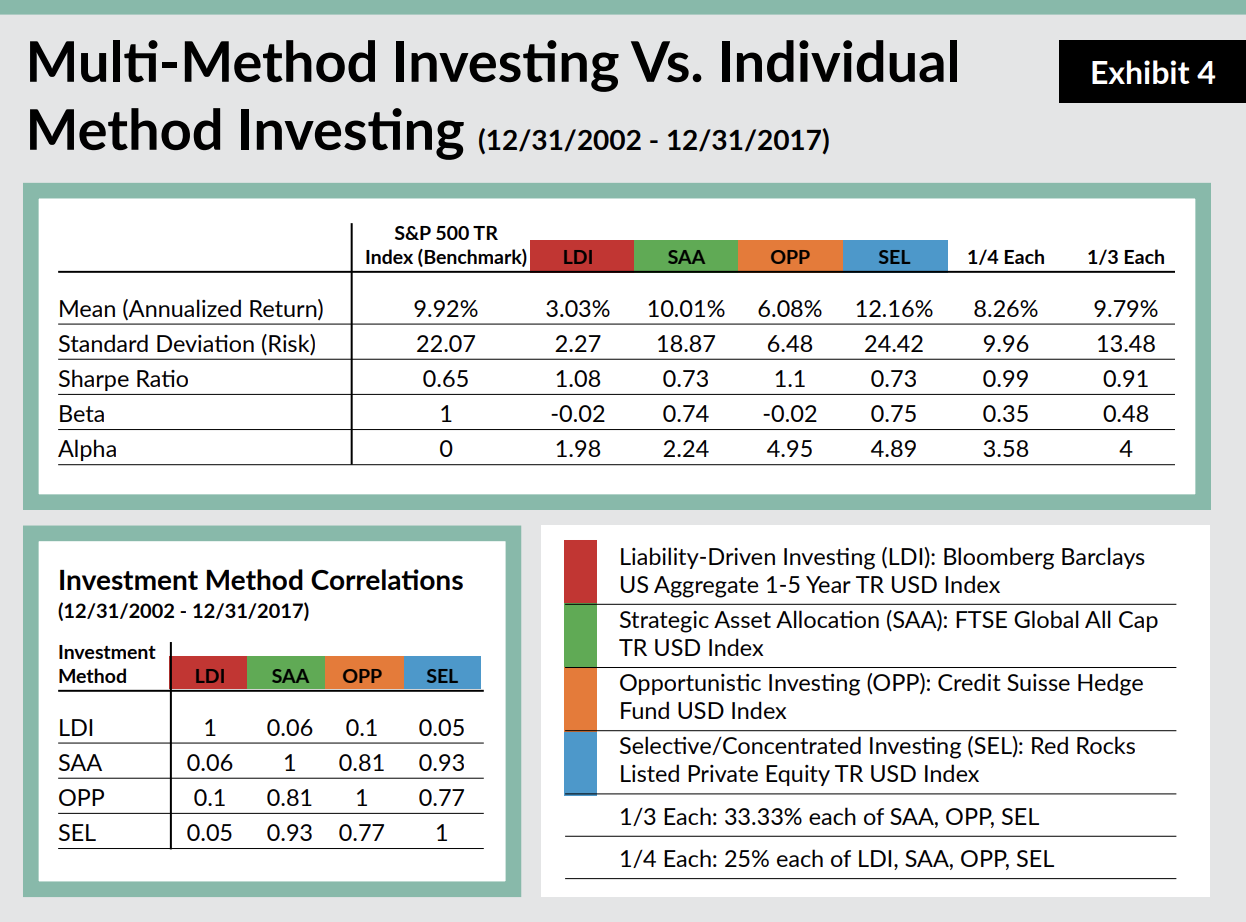
The first multi-method portfolio, labeled “1/4 Each”, is composed of 25% of each of the 4 investment method index proxies. The higher the Sharpe Ratio, the better the risk-adjusted return. When comparing the Sharpe Ratios of the 1/4 Each portfolio and the Strategic Asset Allocation portfolio (the most widely used and accepted investment method), we find the 1/4 Each portfolio has a slightly lower average annualized return (8.26% vs. 10.01%), but a much lower volatility (risk) level (9.96% vs. 18.87%), leading to a better Sharpe Ratio (0.99 vs. 0.73). This means that using the 1/4 Each multi-method portfolio may result in giving up some potential returns, but dramatically reduces the portfolio volatility level relative to a traditional globally diversified stock portfolio allocation (Strategic Asset Allocation). However, comparing a 1/4 Each multi-method portfolio to a 100% stock portfolio is not necessarily a fair comparison for either party. This is because one of the components, Liability-Driven Investing, is heavily bond-oriented and tends to have a much lower risk/return profile (lower volatility, lower long-term returns) than the other three methods.
In the context of Multi-Method Investing®, LDI should be viewed separately from the other 3 methods since it is the only potential “fixed” component in which returns ostensibly can be “locked-in” (for example, by using a laddered or bulleted bond portfolio held to maturity) assuming no default, whereas the other 3 methods are completely variable in their potential returns/risks. LDI may be better viewed as the prerequisite “base of the pyramid” and as an overall portfolio risk reduction tool when creating multi-method allocations rather than being viewed as a component to be mixed with the remaining 3 “variable” methods. In this respect, Strategic Asset Allocation, Opportunistic Investing, and Selective/Concentrated Investing have more similarities with each other than any of them have with Liability-Driven Investing. This idea is statistically supported by the historical correlations data table provided in EXHIBIT 4.
For the above reason, we’ve included a second multi-method portfolio in EXHIBIT 4, which serves as a fairer comparison between an allstock strategic asset allocation (as is used here in “SAA”) and Multi-Method Investing®. This is labeled as “1/3 Each”, and is composed of 33.33% each of the Strategic Asset Allocation, Opportunistic Investing, and Selective/Concentrated Investing index proxies. When comparing this 1/3 Each portfolio to the Strategic Asset Allocation (SAA) portfolio, we find only marginally lower average returns (9.79% vs. 10.01%), much lower volatility (risk) (13.48% vs. 18.87%), and thus a higher Sharpe Ratio (0.91 vs. 0.73).
Surprisingly (given its widespread popularity), Strategic Asset Allocation was tied with Selective/Concentrated Investing for the lowest Sharpe Ratio of all 4 of the individual methods for the time period referenced, although they were both still better than the benchmark used here, the S&P 500 Index. These results point clearly to the potential risk reduction benefits of opening up the portfolio toolkit to include more than just the most popular approach to investing, and specifically to the benefits of the Multi-Method Investing® approach over the more widely currently utilized Strategic Asset Allocation approach.
There is a significant potential drawback to the use of Multi-Method Investing® versus Strategic Asset Allocation - one which was not immediately apparent when we conducted our preliminary internal and theoretical research, but that became apparent once the methodology was put into practice - and it has to do with the emotions and expectations of investors. By nature (and/or by design), some of the 4 investment methods used in Multi-Method Investing® have low correlation returns with the broader stock markets and widely publicized indexes such as the S&P 500. This is particularly true of Opportunistic Investing, some forms of Selective/Concentrated Investing, and Liability-Driven Investing, whereas Strategic Asset Allocation tends to correlate more highly with broad stock market indexes. We have found that some investors become skittish when they see parts of their portfolio move in a different direction from broad market indexes. This is particularly true when it occurs for an extended period of time while the broad market indexes are on the rise, and is at least partially related to the fact that media outlets tend to report only on a very limited set of indexes that may have little or nothing to do with the objectives of the investor. This leads to an increased tendency for investors to “jump ship” on particular methods (often at the wrong time), and requires greater investor education and coaching relative to the more widely used and familiar Strategic Asset Allocation. So even though Multi-Method Investing® may potentially be superior from a theoretical/ analytical standpoint relative to single-method approaches, there is still a great deal of work to be done with regards to practical implementation and managing investor behaviors.
An approach that uses Multi-Method Investing® provides an additional layer of diversification that is not available through a traditional Strategic Asset Allocation portfolio (which is only diversified by asset type, and not necessarily by investment method), or through any other single-method portfolio. Conceptually, Multi-Method Investing® allows one to attempt to achieve one’s investment objectives from multiple angles simultaneously, providing some protection if any one or more of the methods underperforms during a certain time period, and thereby potentially increases the probability of achieving one’s investment objectives in the long term.
Many other studies, which provide the theoretical origins of the current “Factor Investing” movement in the portfolio management industry, have sought to identify various risk premiums or “factors” that are further determinants of portfolio returns. Starting in 1934 with the Graham and Dodd description of the “Value” premium, later with the famous Fama and French 1992/1993 study that developed a multi-factor model, and in many other studies, researchers have sought to identify specific “factors”, “drivers”, and “risk premiums” and decompose portfolio returns into their basic elements. Based on our own research, the author believes that as opposed to describing the broader overall structure of the determinants of portfolio performance, these studies became preoccupied with identifying only minor subsleeves of only one of 4 major risk premiums. Specifically, the “factors” described in these studies and the “Smart Beta” investment products associated with them are actually doing nothing more than tracking sub-premiums associated with the Selective/Concentrated Investing category and its associated major risk premium. Such studies may be missing the forest due to the trees, and are perhaps capturing only a quarter of the total conceptual investment picture.
A “Risk Premium”, is the reward that can be captured by attacking a specific type of risk. The ability to capture different major risk premiums is what may make each of the categories of investment method most successful (on a relative basis) in their respective Bear, Bull, Wolf, or Eagle market environment(s).
We have identified 4 major risk premiums that may be capitalized on by investors:
Credit Default Risk Premium (CDRP): The “Credit Default Risk Premium” can reap rewards from accepting the risk of a potential default by a guarantor, such as a bond or derivative contract issuer. Liability Driven Investing is the investment method that most effectively captures this risk premium – which is theoretically most widely available during Bear markets. This risk premium is closely aligned with the concept of the “risk-free rate” as a basic determinant of portfolio variability and returns, but with the significant caveat that instead of assuming the availability of a return free of risk (which is just a theoretical concept that does not exist in the real world), it assumes that a fixed rate of return (or a return directly related to a hedged asset) can be achieved by accepting a certain amount of credit default risk. The CDRP is most closely conceptually associated with the “risk-free rate” of traditional Modern Portfolio Theory, but may serve as a more accurate and practical replacement.
Systemic Efficiency Risk Premium (SERP): The “Systemic Efficiency Risk Premium” reaps rewards from accepting the risk of fluctuation of the global financial markets as a whole, and is best captured by Strategic Asset Allocation. It is theoretically most widely available during Bull markets. The SERP is most closely conceptually associated with the “asset allocation” of traditional Modern Portfolio Theory, but may serve as a more accurate and practical replacement.
Cyclical Inefficiency Risk Premium (CIRP): The “Cyclical Inefficiency Risk Premium” accepts manager-specific unsystematic (tactical decision making) risk and can be captured by Opportunistic Investing. It is theoretically most widely available during Wolf markets. The CIRP is most closely conceptually associated with the “market timing” of traditional Modern Portfolio Theory, but may serve as a more accurate and practical replacement.
Secular/Structural Inefficiency Risk Premium (SIRP): The “Secular/Structural Inefficiency Risk Premium” accepts security-specific unsystematic (concentrated security selection) risk and may be captured by Selective/Concentrated Investing. It is theoretically most widely available during Eagle markets. The SIRP is most closely conceptually associated with the “security selection” of traditional Modern Portfolio Theory, but may serve as a more accurate and practical replacement.
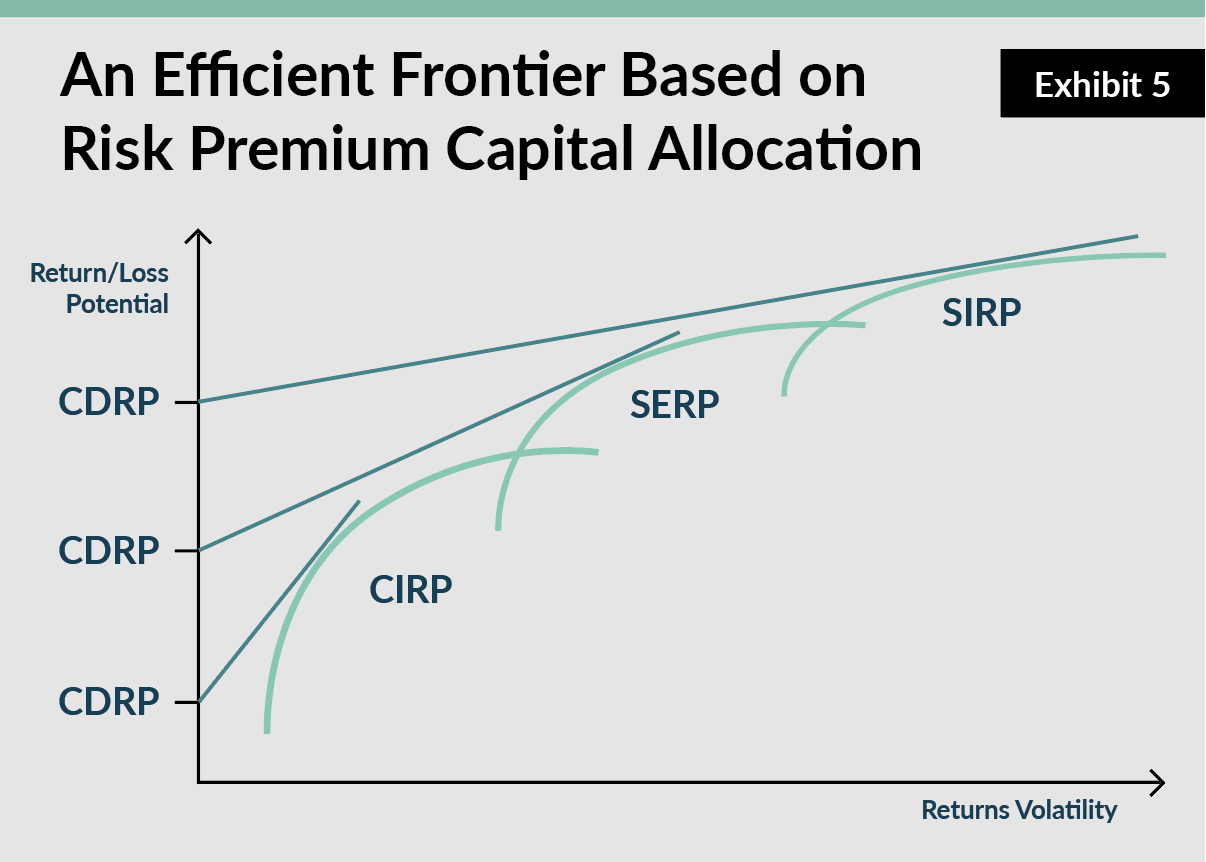
As mentioned earlier, we do not suggest that one attempt to predict which type of market environment is coming, but instead build a portfolio that may use multiple investment methods at the same time so that the overall portfolio is prepared for whatever contingency it may face. But the question is: What methods should one use, when should one use them, and how much of each? The theoretical framework needed to answer this question is something we call “Risk Premium Capital Allocation (RPCA)”, which describes the optimal percentage allocation of an investor’s capital to the major risk premiums. These 4 risk premiums can be plotted on a chart to create an “efficient frontier” similar to the one used in Modern Portfolio Theory, which tells us the most optimal combination of risk premiums (and thus investment methods) for a range of investor objectives, and thus may provide us with an appropriate Risk Premium Capital Allocation for a given investor (see EXHIBIT 5).
Four Alternative Categories Of Investment Method
Markets Redefined As Bear, Bull, Wolf, Eagle
Market Sequences And Unpredictability
The Logical Link Between Market Environment And Investment Method
The Statistical Link Between Market Environment And Investment Method
Comparative performance characteristics of investment methods across all 4 market environments
Summary of Key Findings and Concepts
Share This Article
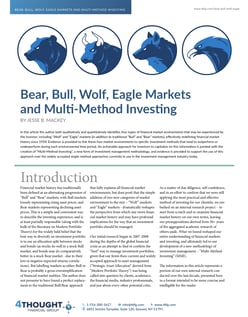 FREE WHITE PAPER
FREE WHITE PAPER

Investment Advisory Services offered through 4Thought Financial Group Inc., an SEC Registered Investment Adviser.
Past performance does not guarantee future results.
The content presented here is for informational purposes only and does not constitute a complete description of our investment advisory services or performance. This document is in no way a solicitation or offer to sell securities or investment advisory services except, where applicable, in states where we are registered (or notice filed) or where an exemption or exclusion from such registration exists. Information throughout this document obtained from outside sources, including index return, prices, and other statistical data, is believed to be reliable, but we do not warrant or guarantee the timeliness or accuracy of this information. Any opinions presented here are subject to change at any time without notice. Readers should conduct their own review and exercise judgment prior to investing. The information provided by 4Thought is for general educational and conceptual purposes only and is not to be interpreted or construed as investment advice meant for particular individuals. Direct investment in an index is not possible. Index returns in this document are presented gross of fees. The returns of the indexes and multi-method index combinations shown do not reflect the deduction of advisory fees, custody charges, brokerage commissions or transaction costs. Such expenses (which would be present if an investor attempted to achieve similar exposures through a mutual fund, exchange traded fund, separate account, or other investment vehicle) would reduce the returns indicated in the accompanying charts/analysis, perhaps very substantially. The index performance data presented here is historical, and the results were thus affected by the financial market and economic conditions present during the time periods referenced. These conditions may be substantially different from those that investors experience in the future, and therefore future results on attempted implementation may be significantly different from the historical performance of the indexes presented here. Investments in vehicles that may be used to attempt to achieve similar exposures to those presented in this document (such as Separately Managed Accounts, exchange traded funds, or mutual funds) may fall as well as rise; are not guaranteed; are invested with a significant risk of loss; are not FDIC-insured; and are not a deposit of or guaranteed by a bank or any other entity. Investors in such vehicles should carefully consider the investment objectives, risks, charges and expenses. The methods and strategy(ies) referenced use investment techniques with risks that are different and in addition to the risks ordinarily associated with equity and fixed income investments. Such techniques include active management risks, non-diversified / concentration risks, unconstrained asset allocation risks, high portfolio turnover risks, debt securities risks, currency risks, and foreign investment risks, which may increase volatility and may increase costs and lower performance.

The information provided by 4Thought is educational only and is not to be interpreted or construed as investment or tax advice.
© 2025 4Thought Financial Group Inc.
Investment Advisory Services are offered through 4Thought Financial Group Inc.,
Registration does not imply a certain level of skill or training. The content presented here is for informational purposes only and does not constitute a complete description of our investment advisory services or performance. This website is in no way a solicitation or offer to sell securities or investment advisory services except, where applicable, in states where we are registered (or notice filed) or where an exemption or exclusion from such registration exists. Information throughout this site, including, but not limited to, stock quotes, charts, articles or any other statement or statements regarding market or other financial information, is obtained from sources which we, and our suppliers believe reliable, but we do not warrant or guarantee the timeliness or accuracy of this information. Nothing on this website should be interpreted to state or imply that past results are an indication of future performance. Neither we nor our information providers shall be liable for any errors or inaccuracies, regardless of cause, or the lack of timeliness of, or for any delay or interruption in the transmission thereof to the user. THERE ARE NO WARRANTIES, EXPRESSED OR IMPLIED, AS TO ACCURACY, COMPLETENESS, OR RESULTS OBTAINED FROM ANY INFORMATION POSTED ON THIS OR ANY LINKED WEBSITE.
Form CRS, Firm Brochure (ADV Part2), Privacy Policy Notice, and Wrap Fee Program Brochure Disclosure BrokerCheck
Any opinions presented here are subject to change at any time without notice. Any comments or postings are provided for informational purposes only and do not constitute an offer or a recommendation to buy or sell securities or other financial instruments. Readers should conduct their own review and exercise judgment prior to investing. Investments are not guaranteed, involve risk and may result in a loss of principal. Past performance does not guarantee future results. Investments are not suitable for all types of investors.
*4Thought Financial Group claims compliance with the Global Investment Performance Standards (GIPS®). GIPS® is a registered trademark of CFA Institute. CFA Institute does not endorse or promote this organization, nor does it warrant the accuracy or quality of the content contained herein. The GIPS firm definition excludes any third party asset management programs over which 4Thought maintains oversight advisory agreements on behalf of its clients, any arrangements under which 4Thought provides recommendations for client self-implementation, and any assets under advisory but not under direct management (in which 4Thought provides allocation changes or trading signals to third party firms but does not take discretion over the trading of client accounts). GIPS-compliant performance information for 4Thought's strategies may be obtained by email at info@4tfg.com; on the 4Thought website at www.4tfg.com/performance-requests; or by phone at (516) 300-1617.
Form CRS, Firm Brochure (ADV Part2), Privacy Policy Notice, and Wrap Fee Program Brochure Disclosure BrokerCheck
Investment Advisory Services are offered through 4Thought Financial Group Inc., an SEC Registered Investment Adviser.
Registration does not imply a certain level of skill or training. The content presented here is for informational purposes only and does not constitute a complete description of our investment advisory services or performance. This website is in no way a solicitation or offer to sell securities or investment advisory services except, where applicable, in states where we are registered (or notice filed) or where an exemption or exclusion from such registration exists. Information throughout this site, including, but not limited to, stock quotes, charts, articles or any other statement or statements regarding market or other financial information, is obtained from sources which we, and our suppliers believe reliable, but we do not warrant or guarantee the timeliness or accuracy of this information. Nothing on this website should be interpreted to state or imply that past results are an indication of future performance. Neither we nor our information providers shall be liable for any errors or inaccuracies, regardless of cause, or the lack of timeliness of, or for any delay or interruption in the transmission thereof to the user. THERE ARE NO WARRANTIES, EXPRESSED OR IMPLIED, AS TO ACCURACY, COMPLETENESS, OR RESULTS OBTAINED FROM ANY INFORMATION POSTED ON THIS OR ANY LINKED WEBSITE.
Any opinions presented here are subject to change at any time without notice. Any comments or postings are provided for informational purposes only and do not constitute an offer or a recommendation to buy or sell securities or other financial instruments. Readers should conduct their own review and exercise judgment prior to investing. Investments are not guaranteed, involve risk and may result in a loss of principal. Past performance does not guarantee future results. Investments are not suitable for all types of investors.
*4Thought Financial Group claims compliance with the Global Investment Performance Standards (GIPS®). GIPS® is a registered trademark of CFA Institute. CFA Institute does not endorse or promote this organization, nor does it warrant the accuracy or quality of the content contained herein. The GIPS firm definition excludes any third party asset management programs over which 4Thought maintains oversight advisory agreements on behalf of its clients, any arrangements under which 4Thought provides recommendations for client self-implementation, and any assets under advisory but not under direct management (in which 4Thought provides allocation changes or trading signals to third party firms but does not take discretion over the trading of client accounts). GIPS-compliant performance information for 4Thought's strategies may be obtained by email at info@4tfg.com; on the 4Thought website at https://www.4tfg.com/performance-requests; or by phone at (516) 300-1617.